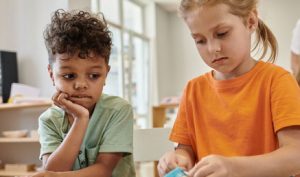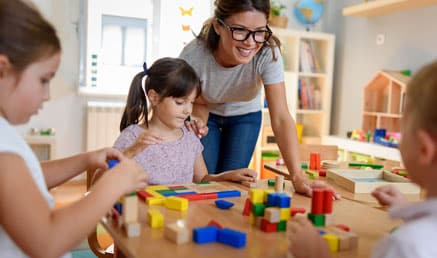
“It’s our polite nudge in the ribs to help you and your team stay organised and on task.”
This week’s subject is: Collaborative learning.
Element 5.2.1: Children are supported to collaborate, learn from and help each other.
How do the educators in your service intentionally create experiences where children can teach and learn from one another, and how might this practice strengthen their sense of agency and community?
When educators reflect on practice, considering questions like the above prompts them to examine their practice critically. It challenges them to consider whether they’re truly embedding opportunities for children to collaborate, not just as participants but as active contributors to their learning environment.
Educators intentionally create environments and experiences that foster children’s social and emotional development, strengthening their sense of agency. The Early Years Learning Framework suggests that agency has two parts. The first part focuses on a child’s ability to make choices in their world. The second part is that children understand the future implications of their choices.
At its core, Element 5.2.1 recognises that children thrive when they engage in a range of meaningful interactions and collaborative experiences with each other. Thinking beyond simply planning group activities, educators foster environments where children actively learn from and support each other, building skills in communication, empathy, and problem-solving, fostering respectful and responsive relationships.
Collaborative learning nurtures essential life skills. When children collaborate, they develop social competence, resilience, and a sense of agency and belonging. These crucial interactions support children to learn to negotiate roles, resolve conflicts, and share ideas, which enhances their emotional intelligence and prepares them for future social contexts.
When reflecting on current practice, consider these practical strategies to support collaborative learning:
-
- Planning a range of open-ended experiences based on children’s interests, such as a group investigation into insects or community gardening. Educators can model collaboration by joining in respectfully, asking questions that spark inquiry and scaffold learning.
- Educators supporting children to explore diverse perspectives on issues of inclusion and exclusion and fair and unfair behaviour.
- Create and provide opportunities and resources for children to assume leadership roles, e.g., implement a “buddy system” where older children assist younger children with tasks like building structures or exploring nature or create a rotating roster for roles like “sustainability monitor” or “mealtime assistant” to help clear plates or serve food or snacks and simple roles such as “line leader” .
- Educators support children’s progress through different stages of play, to help them gain confidence in interacting with their peers.
- Educators consistently model collaborative behaviour through their interactions with children and their colleagues. They use follow-up questions to extend group learning, like “How can we all work together to solve this?” This supports children to communicate effectively and understand each other.
- Collaboration is embedded in everyday practice and routines e.g., children collectively helping to pack away, tidy up, set tables for meals etc. This fosters a sense of belonging and community as children learn to contribute to and be responsible for their learning environment.
- Plan group experiences and projects that encourage children to work together to achieve success and strive towards shared goals, e.g., creating a worm farm or planting a herb garden.
- Allocate time and opportunities for relaxed, unhurried experiences that enable children to collaborate and direct their own learning together. Provide additional resources to support and scaffold children’s learning.
- Educators recognise and acknowledge the complex dynamics associated with older children’s relationships and sensitively intervene in ways that promote social inclusion and competence.
- Educators actively teach children about consent through intentional modelling, clear demonstrations, respectful requests for and granting of consent in daily interactions, and by creating safe opportunities for children to practice setting and respecting boundaries.
- Educators proactively and consistently promote a sense of community within the service, fostering children’s sense of belonging.
- Educators intentionally use open-ended questioning during group experiences to spark curiosity,encourage collaborative discussions and foster peer scaffolding.
- Educators leverage their deep understanding of each child’s unique needs, strengths, and behaviours to thoughtfully group children, and organise staff to foster positive relationships, mutual respect, and collaborative learning amongst peers.
As you and your team reflect on these strategies; from modelling consent and open-ended inquiry to fostering leadership roles and shared projects, consider how they amplify each child’s agency, resilience, and sense of belonging. Ultimately, intentional collaboration transforms the learning environment into a vibrant space where children teach, learn, and grow together, laying a strong foundation for lifelong social and emotional competence. When educators truly embrace this approach and embed these practices, they support children to become confident, empathetic contributors in a supportive ECEC Service community that fosters mutual respect and collective discovery.
Resources:
Guide to the NQF- Element 5.2.1
Social and Emotional Development
QA5- Relationships with Children
MTOP- Collaboration with children and young people
Age-appropriate Pedagogies- Collaborative in Action
Collaborating with Children for Effective Programming: Self-Guided Learning Package
Within System7 go to Quality Area 5/Module 5 to submit self-assessment notes and if required, open a QIP issue if you identify any areas of improvement.
The Childcare Centre Desktop has a range of resources to assist services with QA5, Relationships with children. These include Interactions with Children, families and Staff Policy, Educational Program Policy, Program Template, Observation Record, Critical Reflection Template, Behaviour Guidance Guide Promoting and Supporting Positive Behaviour, Meeting Minutes Template and much more.
Resources, NQS Element, Regulation and System7 links:
Childcare Centre Desktop – Childcare Centre Desktop
National Quality Standard – QA 5/ 5.2.1- Collaborative Learning
National Regulations – 73, 74, 155, 156, 168
System7 Module – QA 5/ Module 5
If you have any questions, send us a note via the Contact page here!




